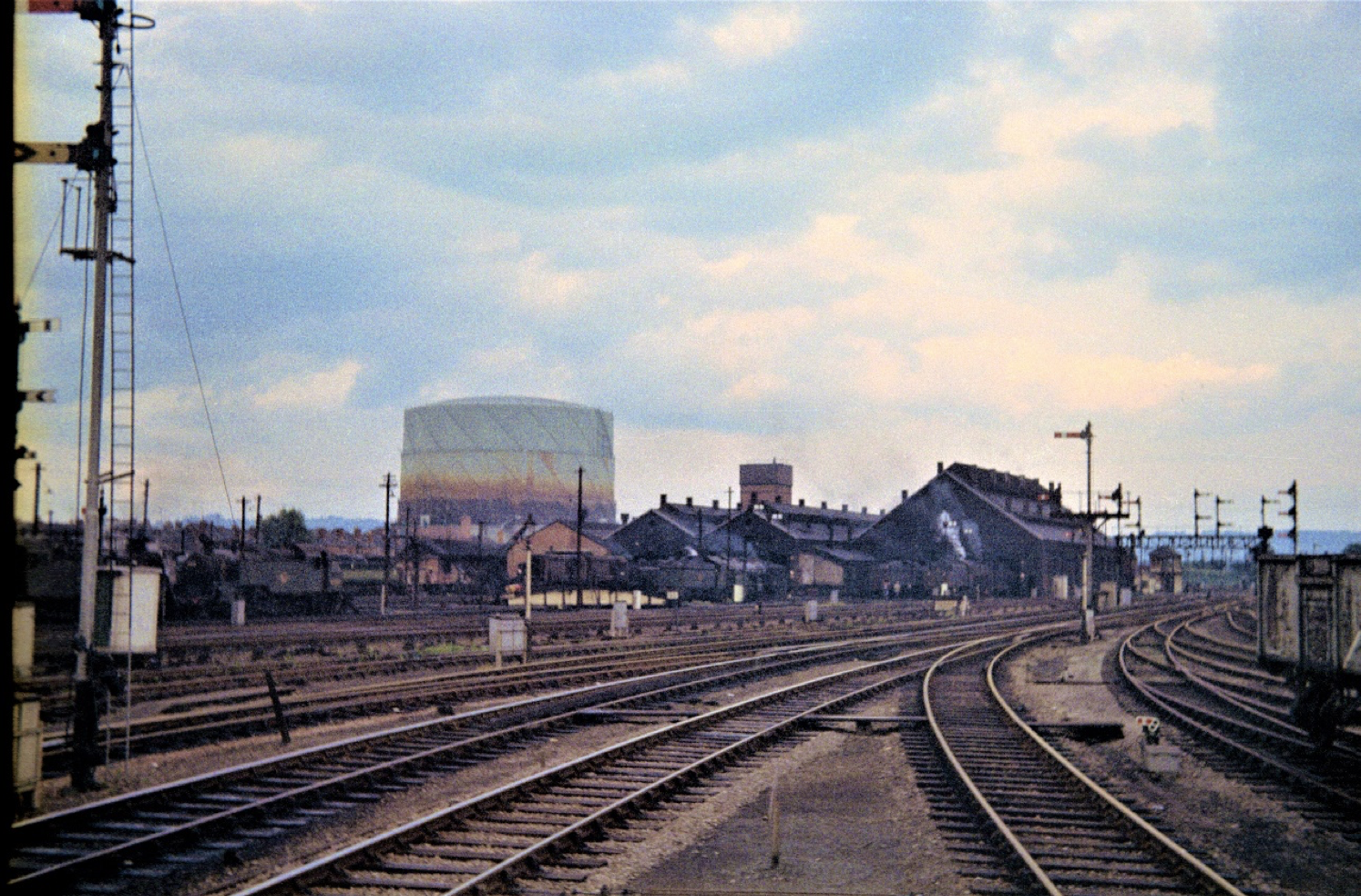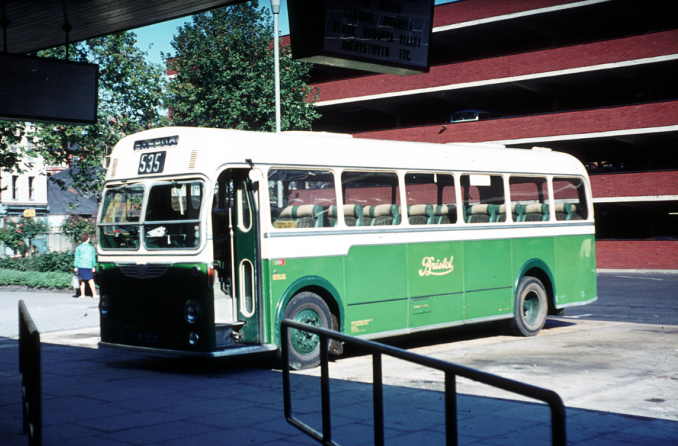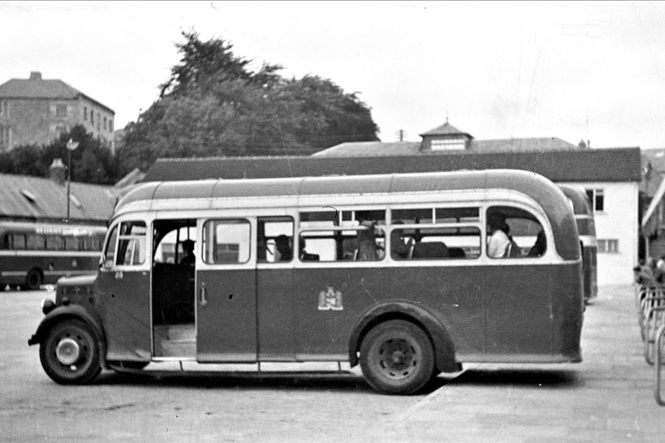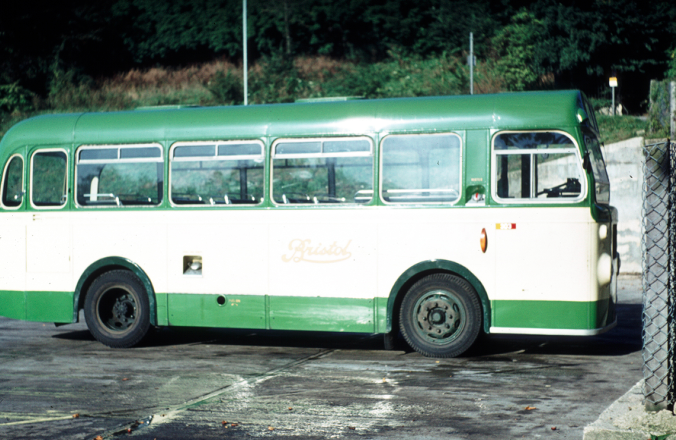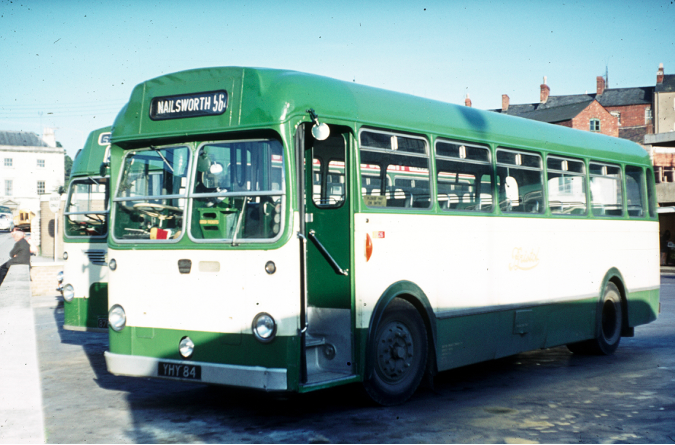BUS SERVICES IN GLOUCESTER
Country Services
I remember one group of country services buses because we travelled on them for quite long journeys. A batch of Bristol KSWs worked the trunk route no. 29 from Bristol to Cheltenham. Introduced in 1952, these were some of the first to have enclosed platforms and saloon heaters, being 8078-81, OHY941, etc. Over time, LDs replaced KSWs, and by about 1968 REs took over the service, although the route was later cut back from Cheltenham to Gloucester, the shortfall being replaced by a more frequent service on route no. 49 between the two towns.
As a family we used the buses quite frequently. One early excursion was to catch the no. 58 Painswick bus as far as the Beacon and walk across towards the village. On one occasion I remember seeing the radiator of the old L-type hissing out steam having overheated on the climb of Upton Hill.
The first underfloor engine single-decker was the LS, superseded in 1957 when the MW was introduced. An updated version of the light bus, the LH was introduced in 1966. By 1967 Bristol-engined vehicles were phased out.
The LS was another of my favourite buses, which were used on route no. 26 between Gloucester and Bristol via Dursley and Wotton. The buses were often dual-purpose vehicles with high backed seats in green and cream moquette and green leather trim. The journey took well over 2 hours, and Dad always made a point of showing me where the entrance to Leyhill open prison was when we went past. Quite often a trusted prisoner on day release would board the bus there. By the late sixties, this route had become the haunt of RELH dual-purpose coaches, a regular performer being 2041 KHW310E.
I also remember my first trip on an RE in Country service in 1967. Gloucester had just received 1010 LAE345E, and I was impressed by the smoothness and speed as we rode up the A38 to Tewkesbury on route no. 50 to Evesham (later to become no. 535).
The coach fleet operated under the Bristol Greyhound fleetname and sported a cream livery with green lining. In 1960 this was changed to a crimson lining, which remained until the advent of the NBC in 1970.
During the 1960s changes occurred to Country services. Firstly, a new unified route numbering system was introduced for the whole Bristol Omnibus network. Most Bristol City (Joint Services) routes were numbered below 100, whilst those in the Weston area were numbered in the 100 no. series. Bath Services routes were numbered in the 200 no. series, and Country services radiating from the Bristol area were numbered in the 300 no. series. Services in the Stroud Valleys were numbered between no. 400 (Bristol to Stroud) and no. 470 (Gloucester to Malmesbury), whilst the 500 no. series were reserved for services based on Gloucester and Cheltenham. Gloucester City services were numbered between no. 500 and no. 518, and Cheltenham District services between no. 581 and no.599.
Bristol MW 2418 HAE262D in dual-purpose livery at Gloucester Bus Station in 1970 laying over before working route no. 535 to Evesham. The green/red coloured fleet number suggests that this bus appears to be on loan from Lawrence Hill, the headquarters of Bristol Omnibus.
The table below gives the service levels, in terms of buses per day for trunk routes operating from Gloucester in 1968:
| Route no | From | To | M-F | Sat | Sun |
| 526 | Gloucester |
Bristol via Dursley, Wotton-under-Edge |
19 | 19 | 6 |
| 529 | Gloucester | Bristol via Berkeley | 14 | 14 | 11 |
| 535 | Gloucester | Evesham via Tewkesbury | 8 | 9 | 4 |
| 536 | Gloucester | Norton Green | 5 | 4 | – |
| 547/8 | Gloucester | Cheltenham via Churchdown | 31 | 28 | 8 |
| 549 | Gloucester | Cheltenham direct | 68 | 71 | 33 |
| 550 | Gloucester | Cheltenham via Brockworth | 8 | 7 | 5 |
| 551/3 | Gloucester | Dursley via Frocester | 12 | 12 | 4 |
| 552 | Gloucester | Stonehouse via Haresfield | 4 | 4 | – |
| 554 | Gloucester | Witcombe | 50 | 65 | 23 |
| 555 | Gloucester | South Cerney | 6 | 8 | 3 |
| 556 | Gloucester | Nailsworth | 20 | 27 | 10 |
| 557/8 | Gloucester | Stroud via Painswick / Malmesbury | 21 | 21 | 8 |
| 567 | Gloucester | Sharpness | 6 | 5 | – |
| 568 | Gloucester | Frampton-on-Severn | 10 | 11 | 2 |
| 572 | Gloucester | Malvern | 4 | 5 | 3 |
| 573 | Gloucester | Ledbury via Bromsberrow | 12 | 12 | – |
| 575-9 | Gloucester | Ledbury via Newent | 12 | 13 | – |
New express services were introduced with the completion of the M5 to Bristol. Route no. 701 ran direct from Gloucester to Bristol on Saturday from December 4 1971: the return fare being 57p.
However, as the 1970s progressed, inflation and a rise in oil prices meant that service cutbacks occurred. On 23 August 1976 routes to Ledbury via Newent (nos. 575-9) were replaced by several independent operators including Bennetts and Powell of Ledbury. Local service no. 581 was also withdrawn, leaving Red & White to provide the service to Newent on route no. 63.
On 31 October 1976 trunk route no. 529 was replaced by express route no. 820, avoiding Thornbury, and no. 530 introduced to serve Berkeley each service at a two-hour frequency.
Other express services introduced previously were renumbered on 25 April 1976 including routes nos. 700-2 from Gloucester to Cheltenham and Bristol, and Stroud to Bristol, which became nos. 825, 821 and 830 respectively. Finally route no. 555 was cut back from South Cerney to Cirencester from 7 August 1977.
In 1969 a system of colour coding was introduced to indicate allocation to divisions, the colours being applied as background to the fleet number plates. By 1972 the colour code had been expanded to include a colour for individual garages. The primary (divisional or area) colour was applied to the left half of the plate, and the secondary (garage) colour to the right half of the plate.
In July 1974 the colour-coding system was superseded by a system of two-letter garage codes displayed on plates next to the fleet number. The table below compares the colour combinations and garage codes:
Bristol Omnibus Depots
| Division | primary colour | Garage | secondary colour | Code |
| Bristol | Green | Marlborough St (Country services) | White | MH |
| Lawrence Hill | Red | LH | ||
| Muller Road | Black | MR | ||
| Staple Hill | Black | SH | ||
| Winterstoke Road | Brown | WE | ||
| Avonmouth | Brown | WE | ||
| Hanham | Magenta | HN | ||
| Brislington | Orange | closed | ||
| Southern | Blue | Weston-super-Mare | White | WM |
| Bath | Red | BH | ||
| Wells | Black | WS | ||
| Devizes | Brown | BH | ||
| Trowbridge | Orange | TE | ||
| Northern | Yellow | Gloucester | White | GR |
| Stroud | Red | SD | ||
| Swindon | Black | SN | ||
| Cirencester | Brown | SN | ||
| Cheltenham | Orange | CM |
Ref: bcv.robsly.com
Stroud
Stroud was an interesting place as it was the home of two types of bus not garaged elsewhere locally. One was the lowbridge Bristol K, which worked most double-deck routes in Stroud owing to the restricted height of the bridge under the railway at Rowcroft. This affected most double-deck routes in the Stroud area, but particularly the trunk 421 service from Chalford to Stonehouse.
The other class was the Bedford OB, one of which I managed to photograph at Merrywalks bus station in 1960. These were normally used on route no. 430 to Ruscombe or to Uplands, as the lanes on these routes were very narrow and unsuitable for full-size single-deckers. These were replaced in1960 by the Bristol SUS a small 30-seat bus suitable for these routes.
Bedford OB / Duple 213 MHU58 waits to leave Stroud bus station on the 430 service to Ruscombe on 26 July 1960
My first experiences of Stroud services were in the late 1940s. My mother’s parents, the Pearces, lived in Randwick, and we’d go over to see them from Tuffley boarding the bus at the ‘New Inn’, now the ‘Fox & Elm’. How I remember the snail’s pace at which they climbed Horsepools Hill up to Edge.
This was before the impact of the creation of the British Transport Commission was felt. The Gloucester – Nailsworth service was operated by Red & White until, with the advent of the Transport Holding Company (set up by the BTC) in 1950 it became Bristol Tramways route no. 56. Meanwhile, local services in the Stroud area were the responsibility of Western National, in which the Great Western Railway had an interest. With the 1950 changes, these routes also became the responsibility of the Bristol Tramways.
Even so, the provenance of the lowbridge Ks in Stroud was clear from the Devon registrations that they held, including KUO932/45/59/64 and LTA723. Most of the former Western National routes in Stroud were allocated 400 numbers in a separate series. An interesting, if unexpected postscript to this era occurred as late as 1970, when Bristol Omnibus took over the Trowbridge operations of Western National with 24 buses. As a result, it acquired further lowbridge KSW buses, several of which migrated to Stroud, as well as some ex-Bristol FSFs that had been transferred previously to Western National.
[One interesting transfer, although not directly related, occurred in 1970 when 27 Bristol Joint Services FLFs were transferred to West Riding to replace their troublesome Guy Wulfranian fleet]
Two shots taken at Stroud in 1970:
Above: Bristol SUS 303 863RAE parked in the London Road depot. They were used on services to places inaccessible to normal-size buses, such as Ruscombe, Uplands or Kingscourt, and on local services in Nailsworth.
Below: Bristol LS 2926 YHY84 in the reversed livery adopted for one-man-operated buses, at Merrywalks Bus Station, working a short service on route no. 564 from Stroud to Nailsworth.
National Bus Company
On 1 January 1969 the NBC was created, and the Bristol Omnibus Company as one of the BTC group companies became part of the NBC, along with other companies in the BET group. In 1970 BOC had 1228 vehicles in its fleet. The first deliveries to the revamped company were Bristol REs, in leaf green with grey window surrounds, and the National ‘double N’ symbol. In late 1972 the company took its first deliveries of the Leyland National, which had been built to NBC specification at a new plant at Lillyhall, in Cumberland. All constituent companies were obliged to take these buses. The initial batches were certainly well-powered but had a very soft suspension which meant they tended to lean considerably when cornering. The standard double-decker became the Bristol VR / ECW combination until this model was phased out in 1981, to be replaced by the Leyland Olympian with ECW or Roe bodies. Olympian chasses were built in Bristol until closure of Bristol Commercial Vehicles in August 1983.
In late 1980 the first withdrawals of Bristol REs started, some of these buses being only 13 years old. However, newer Bristol LHs were coming off-service also, some being only seven years old, although this was partly due to reductions in service levels, particularly on country routes.
A change of Government led to the eventual breaking up of the National Bus Company, and on 11th September 1983, the Bristol Omnibus Co. Ltd. operating area was split; the northern part becoming the Cheltenham & Gloucester Omnibus Co. Ltd. The southern part of Bristol Omnibus was subsequently split: from 1 January 1986 Bristol City services becoming City Line, whilst Country services based on Bristol were renamed Badgerline.
With the creation of the Gloucester & Cheltenham Omnibus Co., an aircraft blue livery was introduced for Gloucester buses, with ‘City of Gloucester’ fleetnames and the City coat of arms. Swindon and District and Cheltenham District buses wore poppy red livery; the Cheltenham fleet also displaying the town’s coat of arms. Stroud Valleys wore leaf green, and ‘Cotswold’ was introduced as a fleetname for coaches in the fleet. On 28 April 1985, the Cheltenham-based Black & White operations of National Travel (West) were absorbed into Cheltenham & Gloucester Omnibus Co. Ltd. Finally, on 1 November 1986 a management purchase was made, the company being renamed Western Travel Ltd.
One result of the break-up of the NBC was the freedom for independent operators to order new buses from the free market, rather than being obliged to wait for buses from the Bristol/Leyland/ECW stable. Consequently, the production of Bristol chasses at Brislington ceased, and the Eastern Coach Works body-building plant in Lowestoft closed 30 January 1987: although bodies to ECW specification were being produced for the Leyland Olympian at Lillyhall for a limited time afterwards.
In December 1985, the minibus revolution came to Gloucester, with the setting up of the ‘Metro’ fleet, involving the introduction of a fleet of Ford Transits in the C614SFH batch on routes using Barton Street. The routes were renumbered, the Matson, Coney Hill and Abbeydale routes becoming nos. 1, 2 and 3. This resulted in a theoretical combined frequency of 32 buses an hour on Barton Street, which was impossible to sustain in practice. Much ‘bunching’ occurred; and in peak hours, minibuses frequently filled up on the first few stops on their inward journey. Interestingly, a similar network of minibus routes in Cheltenham was given letters, a peculiarity that exists to this day.
The Transits were not very popular, being ironically referred to as ‘bread vans’, as they were very cramped with no room for luggage or bags, and were soon supplemented by Mercedes 608D minibuses, initially with Mercedes bodies and increased seating capacity. However, in December 1993 Stagecoach bought out Western Travel, and from 1994 they introduced new batches of Mercedes 709D minibuses with Alexander bodies initially in the L685CDD series to work minibus services in Gloucester, Cheltenham and Stroud.
Another example of the way in which the allocation of buses to key routes over the years has changed can be seen by reference to the trunk Gloucester – Cheltenham route (nos. 49, 549, and later 94). In the mid-sixties it was run by conductor-operated FLFs on a 15-minute interval service, being replaced by REs from about 1969, and later by Leyland Nationals. From 1980 a fleet of National 2s was employed on the service in the batch nos. 3500 to 3506 (AAE644V etc.), which were subsequently absorbed into the Stagecoach fleet on the acquisition of Western Travel by Stagecoach in December 1993. In 1996 Stagecoach introduced Volvo B10Ms, their standard single-decker, in the batch nos. 401 to 410 (N401LDF, etc.). These were replaced in 2000 by a batch of ‘stretched’ Dennis Darts with Plaxton bodywork, fleet numbers nos. 33501-12 (X501ADF, etc.). However, these were not always capable of handling passenger numbers, so a dedicated batch of Dennis Tridents nos. 18082-91 were introduced in 2004 and ran the service until replaced in 2009 by Scanias in the batch nos. 15521-32 in Gold Service livery (with enhanced passenger comfort and coach seats). The route received a further upgrade in 2016 with a fleet of Scania/ADL double-deckers in the batch nos. 10749-60 with leather seating, Wifi, and electric charging points.
The Cheltenham & Gloucester fleet from 1982 to 1993
| Fleet no | Reg no | Chassis | Body | Seating | Introduced |
| 101-5 | G101AAD, etc. | Leyland Olympian ONLXB/2RZ | Alexander | H51/36F | 1990 |
| 614-44 | C614SFH, etc. | Ford Transit 190D | Alexander/Dormobile | B16F | 1985 |
| 645-8 | C645SFH, etc. | Ford Transit 190D | Alexander/Dormobile | DP16F | 1985 |
| 649-62 | C649XDF, etc. | Mercedes-Benz L608D | Alexander | B20F | 1986 |
| 663-9 | E663JAD, etc. | MCW Metrorider | MCW | B25F | 1987 |
| 670-6 | E670JDG, etc. | MCW Metrorider | MCW | B25F | 1988 |
| 679-84 | G679AAD, etc. | Mercedes-Benz 709D | PMT | B25F | 1989 |
| 2200-2 | A200/2RHT | Leyland Tiger TRCTL11/3R | Plaxton Paramount Expresss 3200 | C57F | 1983 |
| 2211-4 | A211SAE, etc. | Leyland Tiger TRCTL11/3R | Plaxton Paramount 3200 | C53F | 1983 |
| 2215/6 | B215NDG, etc. | Leyland Leopard PSU5D/4R | Plaxton Paramount 3500 2 | C49FT | 1985 |
| 2408-10 | C422WFH, etc. | Leyland Tiger TRCTL11/3RZ | Plaxton Paramount II 3500 | C46FT | 1986 |
| 9500/13 | JHU899, 912X | Leyland Olympian ONLXB/1R | Roe | H47/29F | 1982 |
| 9517-25 | LWS33Y, etc. | Leyland Olympian ONLXB/1R | Roe | H47/29F | 1982 |
| 9533 | NTC132Y | Leyland Olympian ONLXB/1R | Roe | H49/29F | 1983 |
References:
https://rbwaters.wixsite.com/gloucestertransporthistory/
www.petergould.co.uk/local_transport_history
